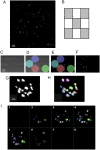No Evidence that Knops Blood Group Polymorphisms Affect Complement Receptor 1 Clustering on Erythrocytes
- PMID: 29259218
- PMCID: PMC5736761
- DOI: 10.1038/s41598-017-17664-9
No Evidence that Knops Blood Group Polymorphisms Affect Complement Receptor 1 Clustering on Erythrocytes
Abstract
Clustering of Complement Receptor 1 (CR1) in the erythrocyte membrane is important for immune-complex transfer and clearance. CR1 contains the Knops blood group antigens, including the antithetical pairs Swain-Langley 1 and 2 (Sl1 and Sl2) and McCoy a and b (McCa and McCb), whose functional effects are unknown. We tested the hypothesis that the Sl and McC polymorphisms might influence CR1 clustering on erythrocyte membranes. Blood samples from 125 healthy Kenyan children were analysed by immunofluorescence and confocal microscopy to determine CR1 cluster number and volume. In agreement with previous reports, CR1 cluster number and volume were positively associated with CR1 copy number (mean number of CR1 molecules per erythrocyte). Individuals with the McC b /McC b genotype had more clusters per cell than McC a /McC a individuals. However, this association was lost when the strong effect of CR1 copy number was included in the model. No association was observed between Sl genotype, sickle cell genotype, α+thalassaemia genotype, gender or age and CR1 cluster number or volume. Therefore, after correction for CR1 copy number, the Sl and McCoy polymorphisms did not influence erythrocyte CR1 clustering, and the effects of the Knops polymorphisms on CR1 function remains unknown.
Conflict of interest statement
The authors declare that they have no competing interests.
Figures




References
-
- Vik DP, Wong WW. Structure of the gene for the F allele of complement receptor type 1 and sequence of the coding region unique to the S allele. J. Immunol. 1993;151:6214–6224. - PubMed
-
- Dykman TR, Hatch JA, Aqua MS, Atkinson JP. Polymorphism of the C3b/C4b receptor (CR1): characterization of a fourth allele. J. Immunol. 1985;134:1787–1789. - PubMed
-
- Moulds JM, Moulds JJ, Brown M, Atkinson JP. Antiglobulin testing for CR1-related (Knops/McCoy/Swain-Langley/York) blood group antigens: negative and weak reactions are caused by variable expression of CR1. Vox Sang. 1992;62:230–235. - PubMed
Publication types
MeSH terms
Substances
Grants and funding
LinkOut - more resources
Full Text Sources
Other Literature Sources
Research Materials
Miscellaneous

